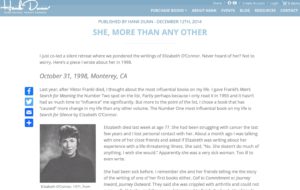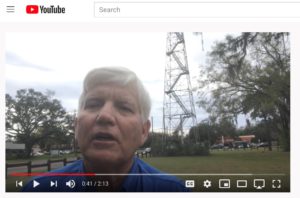Barbara Lazear Ascher’s husband gave her the news in the most straightforward way. “Looks like pancreatic cancer,” he told her matter-of-factly after the test results came back.
She and their friends gave him a wonderful death. They had theme parties with matching drinks. “Dying was intimate, and I drew close,” Ascher writes in her moving memoir, “Ghosting,” “We were single-minded, welded together in the process of this long leave-taking.”
 This is how David Brooks starts a recent piece in The New York Times, “Some People Turn Suffering Into Wisdom.” I might as well borrow from one of the best. Brooks often writes about living life — its goodness and the difficulties. In this one, he covers the landscape of grief and trauma and moving on.
This is how David Brooks starts a recent piece in The New York Times, “Some People Turn Suffering Into Wisdom.” I might as well borrow from one of the best. Brooks often writes about living life — its goodness and the difficulties. In this one, he covers the landscape of grief and trauma and moving on.
This kind of disorientation is brutal … and normal. Grief and suffering often shatter our assumptions about who we are and how life works. The social psychologist Ronnie Janoff-Bulman notes that many people assume that the world is benevolent, that life is controllable, and that we are basically good people who deserve good things. Suffering and loss can blast that to smithereens.
My few (and relatively small) hard knocks in life taught me years ago about the lesson of impermanence. That is — all things change. The grief that follows loss bumps up to this piece of wisdom. This is normal. I have written before about my habit of journaling. I didn’t say then that I tend to journal more and with more passion when things are not going so well in my life. Brooks introduced an exercise to use journaling to tell our stories differently.
Gradually the process of re-storying begins. This is taking a now fragmented life and slowly cohering it into a new narrative. The social psychologist James Pennebaker has people do free expressive writing, sometimes for just 20 minutes a day for four days. Don’t worry about spelling and grammar, he advises; just let it flow — for yourself. In the beginning, people who take part in expressive writing exercises sometimes have different voices and handwriting styles. Their stories are raw and disjointed. But their narratives grow more coherent and self-aware as the days go by. They try on different perspectives. Some studies show that people who go through this process emerge with lower blood pressure and healthier immune systems.
I never took my blood pressure and can’t quantify how much, if at all, journaling helped me. I would have to go back through the losses in my life and do it over WITHOUT journaling — no, thank you. But I do agree with Brooks. Some people take grief and loss and make a new life.
Gradually, for some people, a new core narrative emerges answering the question, “What am I to do with this unexpected life?” It’s not that the facts are different, but a person can step back and see them differently. New frameworks are imposed, which reorganize the relationship between the events of a life. Spatial metaphors are helpful here: I was in a dark wood. This train is not turning around. I’m climbing a second mountain.
David Brooks’ most recent book is The Second Mountain: The Quest for a Moral Life.
________________________________________
Chaplain Hank Dunn is the author of Hard Choices for Loving People: CPR, Feeding Tubes, Palliative Care, Comfort Measures and the Patient with a Serious Illness and Light in the Shadows. Together they have sold over 4 million copies. You can purchase his books at hankdunn.com or on Amazon.

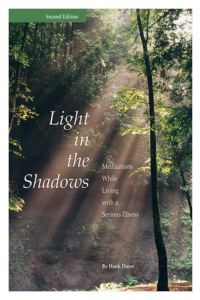
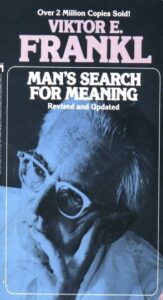 “The experiences of camp life show that man does have a choice of action.… Man can preserve a vestige of spiritual freedom, of independence of mind, even in such terrible conditions of psychic and physical stress.… We who lived in concentration camps can remember the men who walked through the huts comforting others, giving away their last piece of bread. They may have been few in number, but they offer sufficient proof that everything can be taken from a man but one thing: the last of the human freedoms—to choose one’s attitude in any given set of circumstances, to choose one’s own way.
“The experiences of camp life show that man does have a choice of action.… Man can preserve a vestige of spiritual freedom, of independence of mind, even in such terrible conditions of psychic and physical stress.… We who lived in concentration camps can remember the men who walked through the huts comforting others, giving away their last piece of bread. They may have been few in number, but they offer sufficient proof that everything can be taken from a man but one thing: the last of the human freedoms—to choose one’s attitude in any given set of circumstances, to choose one’s own way. I’ve had the opportunity to officiate many funerals over the years. This was supposed to be one of the “easy” ones. The dead man’s family had a relative who once was a member of my church in Vienna, Virginia, back in the day. None of the family attended that church now — or any church. So, when the man died suddenly of a heart attack at 64, they turned to us for a minister to conduct the service — kind of a rent-a-preacher.
I’ve had the opportunity to officiate many funerals over the years. This was supposed to be one of the “easy” ones. The dead man’s family had a relative who once was a member of my church in Vienna, Virginia, back in the day. None of the family attended that church now — or any church. So, when the man died suddenly of a heart attack at 64, they turned to us for a minister to conduct the service — kind of a rent-a-preacher.
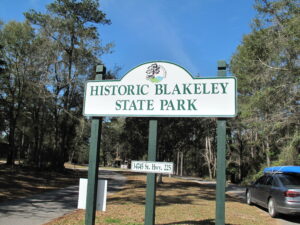 FORT BLAKELEY, ALA. March 1, 2022: What if your teenage son went off to war — fought in one battle — died in that battle — and then you find out his death was actually after the war had ended — AND your side lost the war? Today, we would say parents of these dead soldiers would have complicated grief. Indeed.
FORT BLAKELEY, ALA. March 1, 2022: What if your teenage son went off to war — fought in one battle — died in that battle — and then you find out his death was actually after the war had ended — AND your side lost the war? Today, we would say parents of these dead soldiers would have complicated grief. Indeed.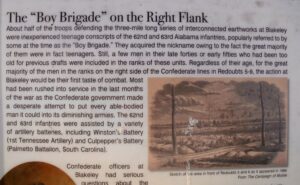

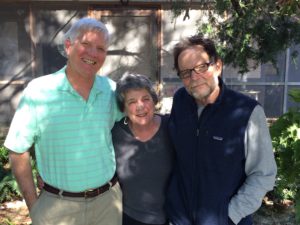
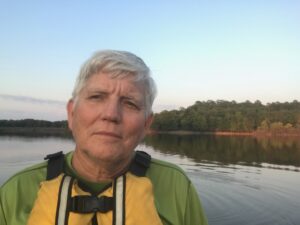
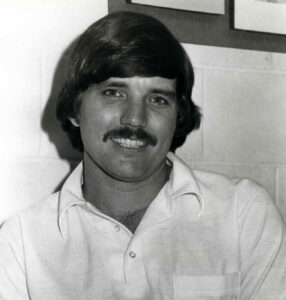

 A young soldier named William Gaston Barringer turned 18 on October 5, 1862. Less than three months later, he was wounded and died as a prisoner of war 200 miles from home. Yet, there is evidence he had a good death. How could this be?
A young soldier named William Gaston Barringer turned 18 on October 5, 1862. Less than three months later, he was wounded and died as a prisoner of war 200 miles from home. Yet, there is evidence he had a good death. How could this be? Plagues in the 1300s killed 40-60% of the European population. Such widespread death led to the release of a couple of books known as the Ars moriendi (“The Art of Dying”). These were Christian instructions on how to have a good death. There were accompanying woodcuts, like one showing demons tempting the dying man with crowns symbolizing earthly pride.
Plagues in the 1300s killed 40-60% of the European population. Such widespread death led to the release of a couple of books known as the Ars moriendi (“The Art of Dying”). These were Christian instructions on how to have a good death. There were accompanying woodcuts, like one showing demons tempting the dying man with crowns symbolizing earthly pride.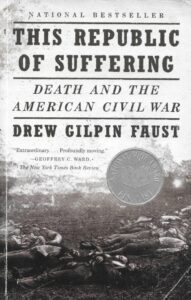 Was conscious
Was conscious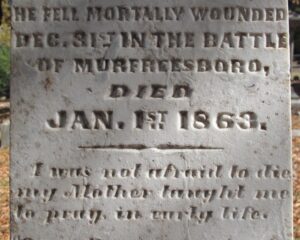 The words on Barringer’s marker were an assurance to his family that he died a good death: “I was not afraid to die; my Mother taught me to pray in early life.” These seem like the dying words of a conscious man.
The words on Barringer’s marker were an assurance to his family that he died a good death: “I was not afraid to die; my Mother taught me to pray in early life.” These seem like the dying words of a conscious man.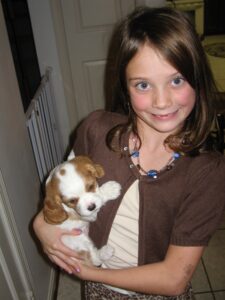
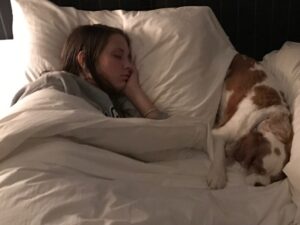 “Charlie” was not a very creative name, but it just seemed to fit a male King Charles Spaniel. At first, we crated him at night. After weeks of barking, he finally settled into his crate and his place at home. Until…
“Charlie” was not a very creative name, but it just seemed to fit a male King Charles Spaniel. At first, we crated him at night. After weeks of barking, he finally settled into his crate and his place at home. Until… Charlie joined Katie in Oxford her second year at Ole Miss, where he supported her during roommate issues and dating cycles. Their deep bond reached new depths. A dog just loves unconditionally.
Charlie joined Katie in Oxford her second year at Ole Miss, where he supported her during roommate issues and dating cycles. Their deep bond reached new depths. A dog just loves unconditionally.

 On Sunday afternoon, my wife and I were pulling into the Walmart parking lot, and she blurted out, “Katie has to come home tonight.” It was a mother’s flash of insight for her soon-to-be grieving daughter. She called Katie and told her to get to National airport and get on a plane. I picked her up in Memphis with Charlie a few hours later. They slept together on our bedroom floor that night before she returned to D.C., Monday. In the car on the way to the Memphis airport, she “Snapped” a photo to friends, “my last photo I’ll ever take with my baby.” Indeed, it was.
On Sunday afternoon, my wife and I were pulling into the Walmart parking lot, and she blurted out, “Katie has to come home tonight.” It was a mother’s flash of insight for her soon-to-be grieving daughter. She called Katie and told her to get to National airport and get on a plane. I picked her up in Memphis with Charlie a few hours later. They slept together on our bedroom floor that night before she returned to D.C., Monday. In the car on the way to the Memphis airport, she “Snapped” a photo to friends, “my last photo I’ll ever take with my baby.” Indeed, it was.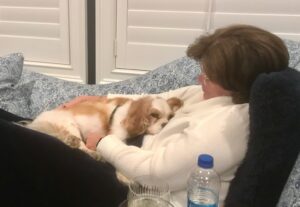
 I was here to ponder how one place can hold so much grief and healing.
I was here to ponder how one place can hold so much grief and healing.
 It turns out her idea was masterful. The Wall has become a place of reflection and healing, a public place to grieve privately. Annually, millions walk the path by the wall in silence, as if in a sacred space — indeed it is. Grown men weep as they touch the name of a fallen comrade. Children visit the names of fathers they never knew.
It turns out her idea was masterful. The Wall has become a place of reflection and healing, a public place to grieve privately. Annually, millions walk the path by the wall in silence, as if in a sacred space — indeed it is. Grown men weep as they touch the name of a fallen comrade. Children visit the names of fathers they never knew. The story is about loss and backpacking, two abiding interests in my life. I’d probably write favorably of anyone who takes their grief on a 1,100-mile backpacking trip. Cheryl Strayed did and wrote about it.
The story is about loss and backpacking, two abiding interests in my life. I’d probably write favorably of anyone who takes their grief on a 1,100-mile backpacking trip. Cheryl Strayed did and wrote about it.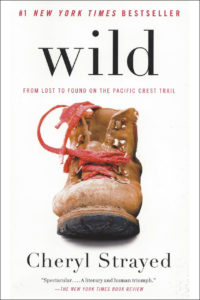 There are many moving passages in the book, but I was caught by one line on the next-to-last page of the book. Cheryl touches the bridge on the Columbia River, the site at the end of her journey. She walks back to an ice cream stand to buy herself a treat with the last two dollars she has to her name. She enjoys her ice cream, chatting with a lawyer from Portland who stops for ice cream, too. She says goodbye to him and
There are many moving passages in the book, but I was caught by one line on the next-to-last page of the book. Cheryl touches the bridge on the Columbia River, the site at the end of her journey. She walks back to an ice cream stand to buy herself a treat with the last two dollars she has to her name. She enjoys her ice cream, chatting with a lawyer from Portland who stops for ice cream, too. She says goodbye to him and